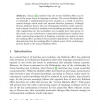466 search results - page 12 / 94 » How to study artificial creativity |
AICOM
2002
13 years 9 months ago
2002
The computational potential of artificial living systems can be studied without knowing the algorithms that govern their behavior. Modeling single organisms by means of socalled c...
CORR
2010
Springer
13 years 9 months ago
2010
Springer
Although backpropagation ANNs generally predict better than decision trees do for pattern classification problems, they are often regarded as black boxes, i.e., their predictions c...
AAAI
2004
13 years 11 months ago
2004
In this paper we discuss a deployed application at Ford Motor Company that utilizes AI technology for the analysis of potential ergonomic concerns at our assembly plants. The manu...
ECAL
2007
Springer
14 years 1 months ago
2007
Springer
Deacon [1] considers that the reverse Baldwin effect can be one of the major forces in language evolution. The reverse Baldwin effect is essentially a redistributional process of g...
KI
2008
Springer
13 years 9 months ago
2008
Springer
The complexity of pedestrian spatio-temporal behaviour calls for the combination of several complementary empirical methods in order to comprehensively understand human motion beha...

